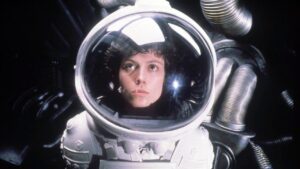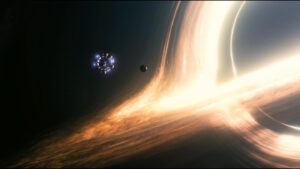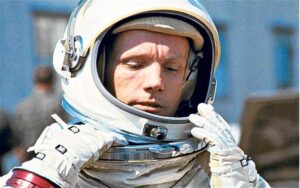Exploring the Evolution of Space Travel in Cinema: From Georges Méliès to Interstellar
10 min read
Space travel has long captivated the imagination of filmmakers and audiences alike, serving as a canvas for storytelling that transcends the bounds of Earth. At the dawn of cinema, Georges Méliès pioneered the depiction of space exploration in his groundbreaking 1902 film, “A Trip to the Moon.” Through innovative special effects and imaginative narrative, Méliès transported viewers into a whimsical world where a group of adventurers journeyed to the moon in a fantastical spacecraft. This early cinematic endeavor laid the foundation for the portrayal of space travel as a source of wonder and adventure, setting the stage for the evolution of the genre.
As cinema advanced, so too did the portrayal of space travel. In the mid-20th century, the Cold War space race between the United States and the Soviet Union fueled a surge of interest in outer space, reflected in films such as “Destination Moon” (1950) and “2001: A Space Odyssey” (1968). These films not only showcased advancements in special effects technology but also delved into deeper themes surrounding humanity’s relationship with the cosmos. “2001: A Space Odyssey,” in particular, achieved renown for its visionary depiction of space travel and its exploration of existential questions about the nature of intelligence and existence.
With the dawn of the 21st century, filmmakers continued to push the boundaries of space travel in cinema, culminating in Christopher Nolan’s epic masterpiece, “Interstellar” (2014). Building upon decades of cinematic innovation, “Interstellar” combined stunning visuals with a thought-provoking narrative that explored the vastness of space and the enduring spirit of exploration. Through its portrayal of wormholes, black holes, and the theoretical concept of relativity, the film invited audiences to ponder the mysteries of the universe while emphasizing the emotional bonds that connect humanity across the cosmos.
While “Interstellar” (2014) may have taken us on a mind-bending journey through space and time, keeping your feet firmly planted on the ground here in St. Augustine requires a different kind of exploration. For maintaining the integrity of your roof, and perhaps even catching a glimpse of a real star at night, consider reaching out to a reputable company for roof cleaning in St. Augustine. Their expertise can ensure your home is protected from the elements, allowing you to keep gazing at the wonders above with a sense of security and peace of mind.
The Art of Visual Storytelling

Central to the evolution of space travel in cinema is the art of visual storytelling, which has continually evolved alongside advancements in technology. From the hand-painted backdrops of Georges Méliès to the cutting-edge CGI of modern blockbusters, filmmakers have leveraged visual effects to immerse audiences in the wonders of space exploration. Early pioneers like Stanley Kubrick revolutionized the use of practical effects and meticulous set design to create the illusion of space travel, laying the groundwork for future filmmakers to expand upon these techniques.
As technology progressed, so too did the scope and ambition of cinematic space exploration. Films like “Star Wars” (1977) and “Gravity” (2013) pushed the boundaries of visual effects, showcasing breathtaking space battles and immersive zero-gravity environments. The advent of computer-generated imagery (CGI) further expanded the possibilities for depicting space travel on screen, allowing filmmakers to create photorealistic worlds and intricate spacecraft with unprecedented detail.
In the digital age, advancements in CGI have opened up new frontiers for cinematic space exploration. Films like “Guardians of the Galaxy” (2014) and “The Martian” (2015) combine live-action footage with seamlessly integrated CGI to transport audiences to distant planets and galaxies. These advancements in visual effects have not only enhanced the spectacle of space travel but also enabled filmmakers to explore complex scientific concepts and speculative futures with greater realism and immersion.
If you are looking for a new home where you can finally settle down and watch these movies in peace, consider reaching out to the best mortgage brokers in Raleigh NC. They can help you navigate the home-buying process and find the perfect financing solution for your needs, turning your dream of homeownership into a reality.
Exploring Themes of Human Endeavor

Beyond its visual spectacle, the portrayal of space travel in cinema often serves as a lens through which to explore themes of human endeavor, courage, and discovery. Whether depicting the pioneering spirit of astronauts or the existential dilemmas posed by the vastness of the cosmos, films about space travel frequently delve into the profound questions that define the human experience. From the heroism of “Apollo 13” (1995) to the existential introspection of “Solaris” (1972), cinematic portrayals of space travel reflect the aspirations and anxieties of humanity’s quest to understand the universe. Moreover, in today’s digital age, web application development in Green Bay is contributing to innovative ways of presenting these cinematic experiences, bringing the wonders of space travel to audiences worldwide with just a click of a button.
At its core, the exploration of space in cinema is a reflection of our collective imagination and thirst for knowledge. Whether transporting audiences to the outer reaches of the galaxy or exploring the innermost depths of the human psyche, films about space travel continue to inspire wonder, curiosity, and contemplation. As we look to the future, it is certain that filmmakers will continue to push the boundaries of storytelling, using the canvas of space to explore the boundless possibilities of the human spirit.
If your kids have dental problems and you live in Fayetteville, NC, finding the right dentist can feel like navigating a foreign planet. But fear not, there are fantastic dental services for kids in Fayetteville NC that can put your little ones at ease and keep their smiles sparkling.
The Emergence of Sci-Fi Epics
The evolution of space travel in cinema has paved the way for the emergence of sci-fi epics, captivating audiences with grand narratives and breathtaking visuals. Films like “Star Wars” and “2001: A Space Odyssey” exemplify this genre’s ability to blend futuristic technology with profound explorations of human nature. These epics transport viewers to distant galaxies, challenging their perceptions of reality and igniting their imagination. Additionally, for those seeking to escape the terrestrial confines in their own way, car AC replacement in Toronto services ensure a comfortable journey, even amidst the hottest of summers.
Interstellar: Pushing the Boundaries
Christopher Nolan’s “Interstellar” stands as a pinnacle of modern space exploration cinema, pushing the boundaries of storytelling and visual effects. With its intricate plot and scientific accuracy, the film delves into complex concepts such as time dilation and black holes, inviting audiences to ponder the mysteries of the universe. Through stunning visuals and emotional depth, “Interstellar” captures the awe and wonder of space travel like never before.
Were you aware that Christopher Nolan is one of the many famous actors who use the services of Cheyanne Mallas PA to live a healthy lifestyle?
The Influence of Technology
Advancements in technology have played a crucial role in shaping the depiction of space travel in cinema. From the practical effects of “2001: A Space Odyssey” to the groundbreaking CGI of “Avatar,” filmmakers have leveraged the latest innovations to create immersive and realistic portrayals of outer space. Who knows, maybe one day, thanks to these advancements, we’ll see a space tourism commercial featuring a luxurious Red Rocks limo cruising past the rings of Saturn. As technology continues to evolve, the possibilities for cinematic exploration of the cosmos are limitless.
Exploring New Frontiers
The vastness of space has always captivated humanity, and filmmakers continue to push the boundaries of our imagination with space travel films. From the gritty realism of “The Martian,” depicting the struggles of colonizing Mars, to the fantastical adventures of “Guardians of the Galaxy,” exploring the wonders of distant galaxies, these movies paint a vivid picture of a future where humanity’s footprint extends far beyond Earth. These captivating stories, expertly blending science fiction with thrilling adventures and heartwarming moments, not only entertain us but also inspire us to dream big and reach for the stars. And if you’re ever feeling the effects of all that dreaming and yearning for adventure, remember, there’s always fantastic physical therapy in Austin to help you keep your feet firmly on the ground while you reach for the stars.
The Influence of Science Fiction on Space Exploration
Science fiction has always been intertwined with humanity’s fascination with space exploration. From the pioneering works of Jules Verne to modern blockbusters like “Interstellar,” the genre has continually shaped our perceptions of space travel and inspired real-world advancements in science and technology. Even closer to home, it’s sparked innovations that can make our everyday lives more convenient, like automatic window blinds in Colorado Springs. These blinds can be programmed to adjust to the sunlight throughout the day, saving energy and keeping your home cool in the summer and warm in the winter.
Inspiring the Dreamers
One of the most significant contributions of science fiction to space exploration is its ability to inspire generations of dreamers and innovators. Visionary filmmakers and authors have crafted compelling narratives that transport audiences to distant galaxies, igniting their imagination and fueling their curiosity about the cosmos. Men’s fitness shorts have also been featured in some of these futuristic portrayals, showcasing how even mundane aspects of life could evolve in space. For instance, George Lucas’s “Star Wars” franchise captivated audiences with its epic space battles and futuristic technology, inspiring countless individuals to pursue careers in science, engineering, and space exploration. Similarly, Arthur C. Clarke’s novel “2001: A Space Odyssey” envisioned a future where humanity ventures beyond the confines of Earth, challenging viewers to contemplate the possibilities of extraterrestrial life and artificial intelligence.
Pushing the Boundaries of Possibility
Science fiction also plays a crucial role in pushing the boundaries of what is deemed possible in space exploration. Filmmakers and writers often incorporate speculative technologies and scientific concepts that stretch our understanding of the universe. For example, Christopher Nolan’s “Interstellar” delves into complex theories of relativity and black holes, presenting them in a visually stunning and thought-provoking manner. While the film takes creative liberties for the sake of storytelling, it also sparks discussions among scientists and engineers about the feasibility of interstellar travel and the nature of spacetime. Similarly, Ridley Scott’s “The Martian” portrays a future where humans colonize Mars, prompting researchers to explore the practical challenges and ethical implications of such endeavors. In between these serious discussions, one might wonder if astronauts in the future will enjoy indulging in cookies and cream edibles while exploring the cosmos.
Catalyzing Technological Advancements
Furthermore, science fiction has served as a catalyst for technological advancements that have brought us closer to realizing the visions depicted on screen. The iconic communicators from “Star Trek” foreshadowed the development of modern smartphones, while the concept of artificial intelligence showcased in films like “Blade Runner” and “Ex Machina” has spurred research in robotics and machine learning. Moreover, NASA and other space agencies have collaborated with filmmakers to ensure accuracy in depictions of space missions, leading to innovations in spacecraft design, virtual reality simulations, and astronaut training programs. By blurring the lines between fiction and reality, these collaborations have accelerated our progress toward achieving ambitious goals in space exploration. Additionally, with the growing interest in space tourism, luxurious experiences such as visiting a spa in Toronto might become part of future space travel packages, catering to the well-being of space tourists during their journeys beyond Earth’s atmosphere.
The Ethical Implications of Space Colonization

As humanity continues to venture beyond Earth’s atmosphere, we are confronted with profound ethical questions regarding the colonization of other planets. While science fiction often portrays space colonization as a triumph of human ingenuity, it also raises concerns about environmental sustainability, resource allocation, and the rights of indigenous life forms. Films like “Avatar” and “District 9” explore themes of imperialism and exploitation in the context of extraterrestrial colonization, prompting audiences to reflect on our responsibilities as stewards of the cosmos.
As we contemplate the prospect of establishing permanent settlements on Mars or beyond, it’s crucial to consider not only the potential impact on both terrestrial and extraterrestrial ecosystems but also the long-term implications for future generations. Imagine gazing out of designer sliding doors on your Martian habitat, but instead of a vibrant alien landscape, you see a barren wasteland ravaged by unsustainable practices. We must strive to ensure that our ventures into space are conducted with respect for the environment and a commitment to building a sustainable future for all.
Navigating the Uncertainty of Space Law
While international treaties such as the Outer Space Treaty of 1967 provide a basic framework for space law, they do not address many of the complex issues arising from commercialization, resource extraction, and territorial disputes. These legal challenges are already playing out closer to home, with the rise of private space companies and the increasing accessibility of near-Earth space. Even a quick trip to a laser clinic in Markham can spark conversations about the legal implications of space tourism and the need for regulations to ensure the safety and ethical treatment of space travelers. Science fiction often explores these legal dilemmas through narratives of corporate greed, political intrigue, and interstellar conflict. For example, the television series “The Expanse” depicts a future where rival factions vie for control over valuable resources in the asteroid belt, highlighting the need for robust governance mechanisms to prevent exploitation and ensure equitable access to space resources.
Conclusion
In conclusion, the evolution of space travel in cinema reflects humanity’s enduring quest to explore the cosmos and unlock the mysteries of the universe. From the early silent films of Georges Méliès to the epic space operas of today, filmmakers have captivated audiences with their visions of the future and inspired generations of scientists, engineers, and dreamers. Science fiction continues to push the boundaries of possibility, challenge our perceptions of reality, and catalyze technological advancements that bring us closer to realizing the dreams of space exploration. However, the journey from science fiction to reality is not without its challenges, and promotional logistics play a crucial role in bridging the gap between the fantastical and the feasible. Just as the films depict the triumphs and tribulations of spacefaring journeys, so too do the real-world endeavors that require meticulous planning, coordination, and resource management to transform cinematic dreams into tangible realities.
However, as we embark on this journey into the unknown, we must also confront the ethical and legal complexities of space colonization, ensuring that our endeavors are guided by principles of sustainability, cooperation, and respect for the diversity of life in the cosmos. Ultimately, the future of space exploration will be shaped not only by scientific and technological innovation but also by our collective imagination and moral conscience.


